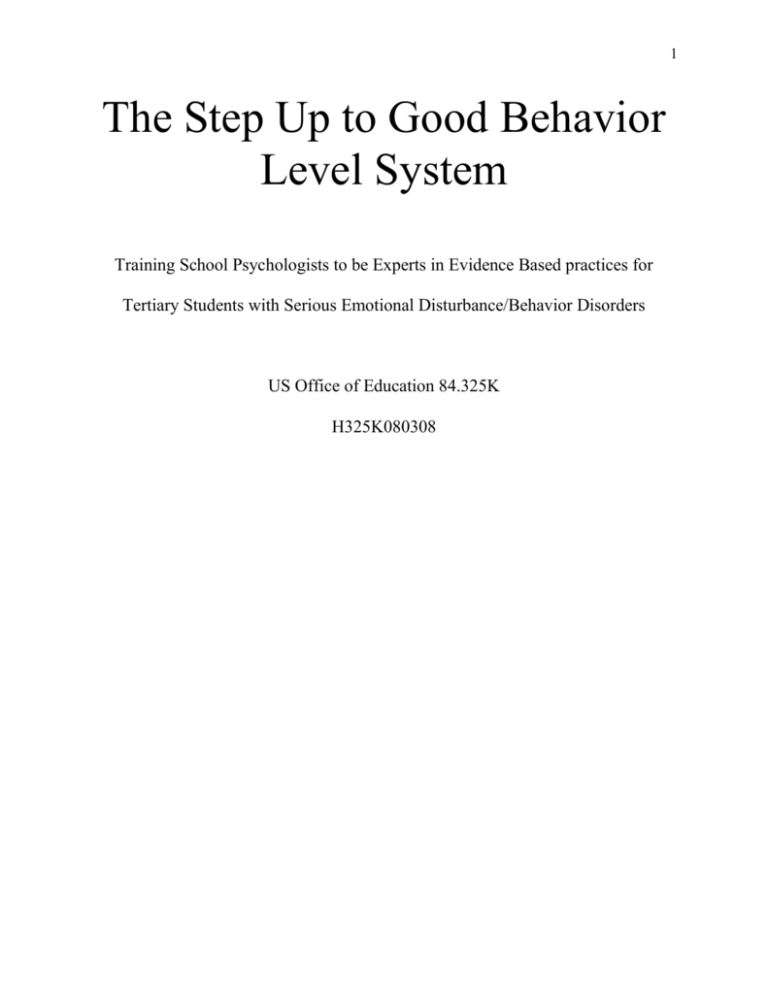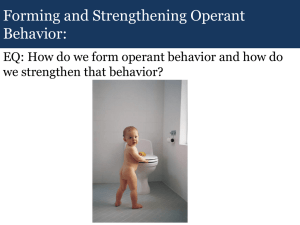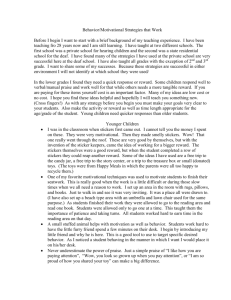The Step Up to Good Behavior Level System
advertisement

1 The Step Up to Good Behavior Level System Training School Psychologists to be Experts in Evidence Based practices for Tertiary Students with Serious Emotional Disturbance/Behavior Disorders US Office of Education 84.325K H325K080308 Introduction has the standard classroom privileges. The highest level is the reward level. On this Many popular interventions in the level the student receives a special reward or schools use only a single behavioral privilege for the day in addition to the technique and are designed to work with an standard classroom privileges and entire classroom. The Step Up to Good reinforcers. Behavior level system combines several behavioral techniques and is designed to modify the behavior of a single child. It is a point based system that primarily relies on Target Population This level system is designed to be positive reinforcement but also includes a used with early elementary school students, reductive consequence. typically 1st to 3rd grade. It can also be This intervention is based on a adapted to use with older elementary school system of different levels of privileges. students by changing the pictures and There are three increasing levels of presentation to be age appropriate for older privileges: Supervision, Trust, and Reward. grades. It should not be used with The Supervision level removes privileges developmentally appropriate middle or and opportunities for reinforcement. It also junior high school students. Level systems removes the student from the environment for children at that age usually have four or where the problem behavior occurs to that more levels and are more complex than the they can succeed in the future. On the Trust Step Up to Good Behavior Level System. level the student is treated like the other The Step Up to Good Behavior Level students in the class. He has access to the System is for use in the general education same reinforcers as the rest of the class and classroom on top of existing class wide 3 behavior management strategies. It is meant any measurable behavior that disrupts as a supplement to rather than a replacement classroom instruction. for those strategies. The level system is If successful the Step Up to Good meant to target the problem behavior of a Behavior Level System will create an single student in the classroom who is not environment where the student can be responding to the existing class wide successful and meet the behavioral strategies. The student targeted by the level expectations of the classroom. system should have a sufficient level of problem behavior that it warrants extra Evidence Base intervention, and he should have control There are no direct studies done on over the behavior. This intervention will not this specific intervention since it is newly likely be successful with students who are developed. However, the components that unable to control the problem behavior. make up the Step Up to Good Behavior Level System are evidence based. The Rationale: What it will do for you The Step Up to Good Behavior Level following is a sample of the research that supports the components of this intervention: System will reduce problem behaviors in the classroom that have not been successfully addressed with less intensive interventions. Level Systems Research has demonstrated that level Examples of the behaviors that it can target systems are an effective means of shaping are aggression, non-compliance, and off-task behavior. Level systems usually consist of a behavior. In short, it can be used to reduce hierarchy of levels. Each level has an 4 increasing level of privileges. Some form of token, such as points, is given to the child Verbal Praise Verbal praise is the practice of throughout the day for appropriate behavior. positively acknowledging and describing, The child is able to move up or down levels with words, desired behaviors to an based on the number of points that they individual who has just demonstrated those earn. behaviors. Hester, Hendrickson, and Gable Jones et al. (1992) demonstrated the (2009) state that teacher praise is a well- use of a level system in a psychiatric documented strategy that can enhance children’s unit. The level system was used to children's behavior, positively impact control behavioral excess and shape teacher-child relationships, and promote prosocial behavior. The study demonstrated teachers' sense of self-efficacy. In another that over time children progressed to higher study Hancock (2002) found that graduate levels, which indicates improving behavior students exposed to verbal praise by the over time. professor had higher achievement levels on Mastropieri, Jenne, and Scruggs exams, spent more time doing homework (1988) evaluated two level systems in a and exhibited more motivation to learn. This resource classroom. Both level systems demonstrates that verbal praise can be an reduced talk-outs and out of seat behavior. effective behavior change tool for people of Assignment completion and accuracy were any age. also increased. This study demonstrated the effectiveness of level systems on different types of behaviors. Mystery Motivator A mystery motivator is an unknown positive reinforcer. It usually consists of a 5 reward written on a piece of paper that is Materials Needed placed in an envelope. The child does not 1. Level Description know what the reward is. When the reward is earned the child opens the envelope to find out what the reward is and then receives 2. Game board 3. Level Chart 4. Rewards Menu 5. Reinforcement Monitoring Sheet it. The fact that the reward is unknown makes it more enticing for the child to earn. In a study Hoag (2007) examined the Steps for Implementation effects of Mystery Motivators versus a menu In order to implement the Step Up to of reinforcers. It was found that the Mystery Good Behavior Level System the following Motivators were more effective at reducing procedures should be followed: disruptive behavior than a menu of 1. Identify the target problem reinforcers. Moore and Waguespack (1994) behavior. For this program you can have two demonstrated that Mystery Motivators are goal behaviors at most so choose the most an effective and socially valid intervention important behaviors. The behavior should be that can be implemented in the classroom observable and measurable. The goals that with integrity. are chosen should help remedy the problem The combination of level systems, behavior and should be worded positively. verbal praise, and mystery motivators They should state what the child should do. provides a system to reward desired 2. Identify appropriate reinforcers behavior with a variety of means. and privileges to earn. Almost anything the child likes can be used as a reinforcer. If in doubt ask them. It should be something that 6 is easy enough or inexpensive enough to reinforcer on a piece of paper and put it in give them almost every day if they continue an envelope. to stay on the reward level. 3. Identify situation in which the 6. Customize the rest of the materials in the appendix for the student. Add their problem behavior occurs. The situation can name and put pictures they like on the be a physical setting, certain peers, or materials to increase their interest. Next, anything in the environment that is related to create a placeholder for the student to use the problem behavior. with the level chart. This can be any random 4. Adjust the sample level system picture as long as it can be used to mark (provided in the appendix) so it fits the which level they are on. A piece of velcro child. The supervision level should be a can be put on each space on the level chart restricted environment where it is less likely and on the back of the placeholder so that it that the problem behavior will occur. This can be easily moved between each level. should also be an environment that is 7. Introduce the child to the level undesirable to the child so they will want to system. They should be told about the progress to the next level. privileges of each level. The behavioral 5. For the reward level decide expectation of the classroom should be made whether you will use a die or spinner as the clear. Emphasis should be placed on the two randomizer. Fill out the rewards menu with goals that the child is working towards. the rewards decided on earlier. Make sure 8. When you catch the child doing one option is a mystery motivator. The the goal behavior verbally praise them and mystery motivator can be any reward. To tell them that they earned a point. Make sure create the mystery motivator write a to be specific in your praise and describe the 7 desired behavior that they performed. Then or use a spinner to determine what his allow the child to fill in a box with the reward will be. appropriate color marker. The color of markers changes based on the time of day to aid in record keeping and make the sheet Troubleshooting and Cautions colorful. 9. Fill out the reinforcement monitoring sheet during each interval to make sure you are giving points when they The intervention may not work properly the first time so some common issues and solutions are as follows. are earned. Put a check mark in the correct box each time the child would have had an opportunity to earn a point. 10.At the end of the day review the child’s progress with him and have him move his marker on the level chart to the appropriate level. If he increases a level or stays on the highest level praise him. Use specific examples of his good behavior throughout the day. If the child remains on a lower level or drops back a level review the day and what he could improve. 11.Once the child reaches the reward level, in the morning have the child roll a die Student is constantly on the lowest level The student should be excited about the intervention and the possibility of receiving rewards on the highest level. If they are not excited the rewards need to be reexamined to ensure that they are motivating for the student. If they are motivated, then the teacher needs to ensure that the supervision level helps remove them from the problem situation and removes reinforcers. Additionally the teacher need to make sure that they are trying to catch the students 8 being good and giving points when up a number at the end if they do not reach deserved. The reinforcement monitoring the goal. sheet can be used to help ensure that points are being given regularly. Finally, the points Student consistently fails to earn points needed to move up a level may need to be Make sure you are looking regularly adjusted at first to make it easier for the to see if the child is performing one of their student and then slowly increase criteria as goals. The reinforcement monitoring sheet students improve can help you track this. A beep tape or some The student may not have the other timed method may be necessary to executive function necessary to inhibit remind you to see if the child has earned a inappropriate behavior. A different point. intervention would need to be tried. Reinforcement may not be happening immediately enough. More points Student earns the number of points to move possible may need to be added to each time up a level or stay and then misbehaves. period. Some students need reinforcement You may need to randomize points needed to move up or stay so student keeps more often than others so more than four times per time period may be needed. trying to earn points. This way they do not know how many point are needed for the day so will not stop trying to earn points. Cautions. For the supervision level you cannot Make sure you actually write down a take away things that the child has a right to number at the beginning of the day so that such as restroom access or food. Make sure the student does not accuse you of making to follow all national, state, and local laws 9 that govern what rewards and consequences can be used with children. The supervision level should be undesirable by the lack of privileges and reinforcement that other students receive. It should not include deliberately aversive stimuli. Thus, you should not have to add anything to the environment only take it away. 10 References Edwards, D., & Roundtree, G. (1981). Assessment of a behavior modification program for modifying disruptive behavior of emotionally disturbed adolescent males in a residential facility. Corrective & Social Psychiatry & Journal of Behavior Technology, Methods & Therapy, 27(4), 171-180. Retrieved from PsycINFO database. Hancock, D. (2002). Influencing graduate students' classroom achievement, homework habits and motivation to learn with verbal praise. Educational Research, 44(1), 83-95. doi:10.1080/00131880110107379. Hester, P., Hendrickson, J., & Gable, R. (2009). Forty years later—The value of praise, ignoring, and rules for preschoolers at risk for behavior disorders. Education & Treatment of Children, 32(4), 513-535. doi:10.1353/etc.0.0067. Hoag, J. (2007). Effects of mystery motivators vs. expected reinforcers on disruptive behavior in preschoolers. Dissertation Abstracts International, 67, Retrieved from PsycINFO database. Jones, R., Downing, R., Latkowski, M., & Ferre, R. (1992). Levels systems as shaping and fading procedures: Use in a child inpatient psychiatry setting. Child & Family Behavior Therapy, 14(2), 15-37. doi:10.1300/J019v14n02. Mastropieri, M., Jenne, T., & Scruggs, T. (1988). A level system for managing problem behaviors in a high school resource program. Behavioral Disorders, 13(3), 202-208. Retrieved from PsycINFO database. Moore, L., & Waguespack, A. (1994). Mystery motivator: An effective and time efficient intervention. School Psychology Review, 23(1), 106. Retrieved from Psychology and Behavioral Sciences Collection database. 11 Appendix: Materials for the level system 12 Date: ______________ _________’s Daily Gameboard FINISH Time Of Day 12 Before Morning Recess After Recess to Lunch After Lunch 11 10 Marker Color Blue Red Green 9 8 7 6 5 4 3 2 Goal 1: Follow Classroom Rules Goal 2: Keep Hands and Feet to Self 1 Goal 1 Goal 2 13 Total Points for the day=_______________ . _____________% Percentage= 14 Level Chart Level 1 Supervision Eat lunch alone Supervised recess- Can play or exercise alone Desk is moved away from the group Sits away from other students during carpet time Level 2 Trust Same privileges as the other students Level 3 Reward In the morning spin to see what the reward for that day will be 15 Rewards Menu 1. 2. 3. 4. 5. 6. Earn coupon for 10 minutes on the swings Earn a coupon to work on an art project with a friend Earn coupon to play a game with principal Mystery Motivator Earn a coupon to help janitor around the building Pick a prize from the prize box 16 Step Up to Good Behavior Level System Level 3 Reward 2 Trust 1 Supervision Description of Level Daily- In the morning spin to see what the reward for that day will be Normal School Privileges Eat lunch alone Supervised recessCan play or exercise alone Desk is moved away from the group Sits away from other students during carpet time Level Change Criteria Stay on level: Earn 15-24 points for the day Move Down: Earn 0-14 points for the day Move Up: Earn 18-24 points for the day Stay on level: Earn 13-17 points for the day Move Down: Earn 0-12 points for the day Move Up: Earn 18-24 points for the day 17 Date: ___________ Reinforcement Monitoring Sheet Rewarded with a point Before Recess After Recess After Lunch Point 1 Point 2 Point 3 Point 4 Point 1 Point 2 Point 3 Point 4 Point 1 Point 2 Point 3 Point 4 Did not earn point








